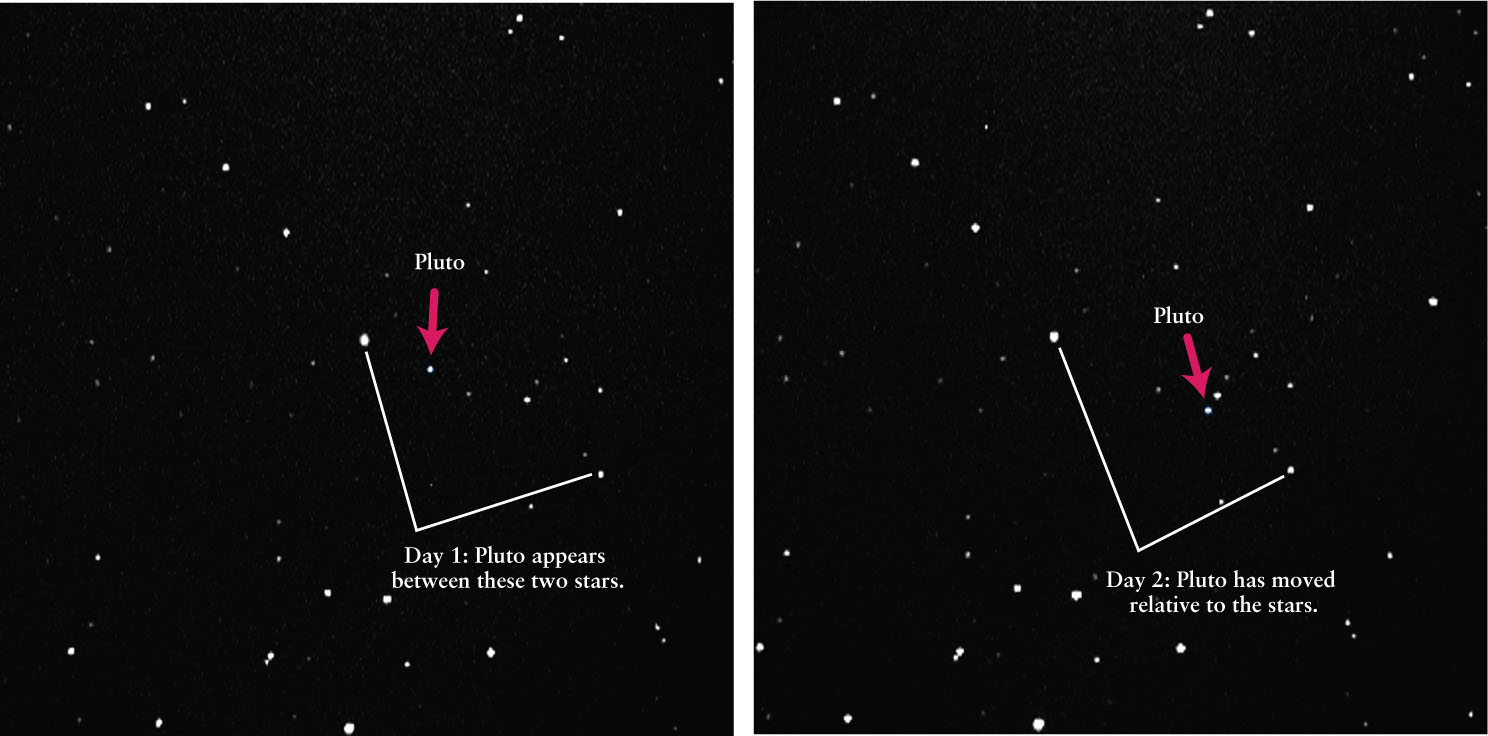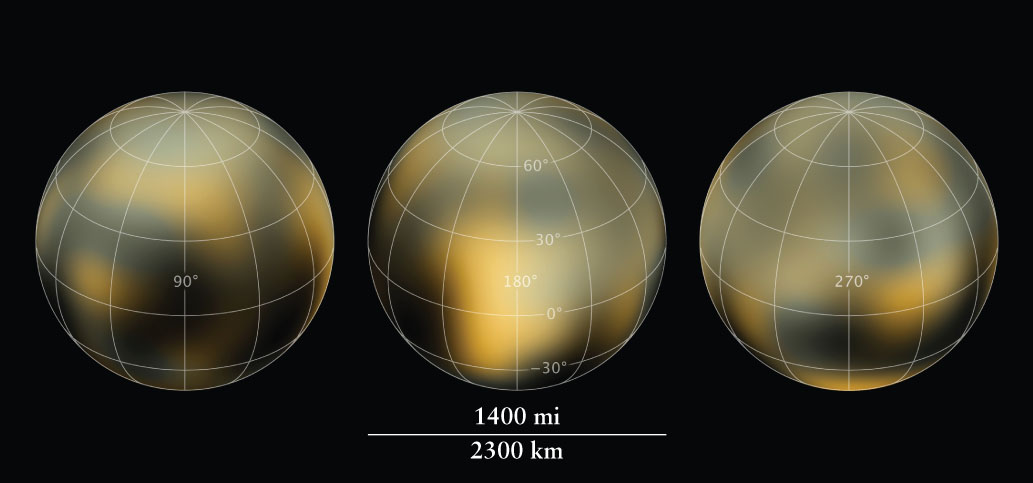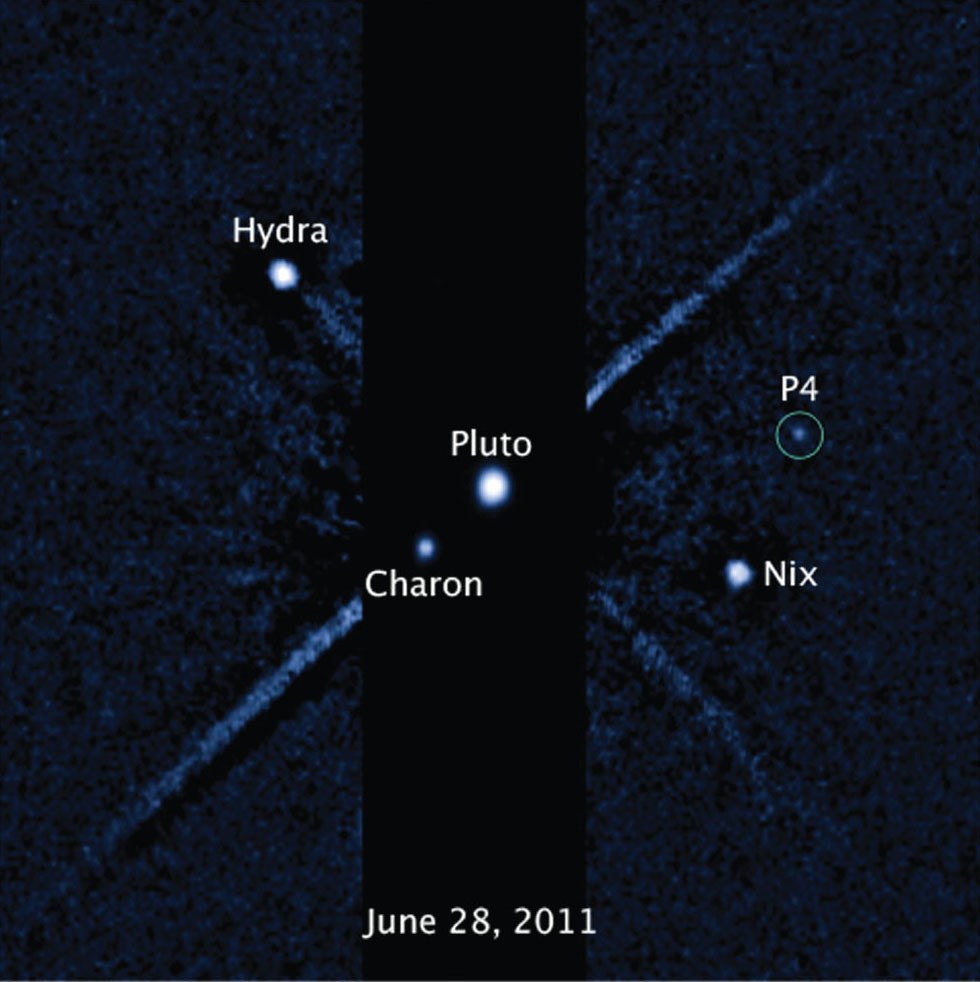14-9 Pluto is smaller than any planet
Speculations about worlds beyond Neptune date back to the late 1800s, when a few astronomers suggested that Neptune’s orbit was being perturbed by an unknown object. Encouraged by the fame of Adams and Le Verrier, several people set out to discover “Planet X.” Two prosperous Boston gentlemen, William Pickering and Percival Lowell, were prominent in this effort. (Lowell also enthusiastically promoted the idea of canals on Mars; see Section 11-4.) Modern calculations show that there are, in fact, no unaccounted perturbations of Neptune’s orbit. It is thus not surprising that no orbiting body was found at the positions predicted by Pickering, Lowell, and others. Yet the search continued.
The Discovery of Pluto
Before he died in 1916, Lowell urged that a special camera with a wide field of view be constructed to help search for Planet X. After many delays, the camera was finished in 1929 and installed at the Lowell Observatory in Flagstaff, Arizona, where a young astronomer, Clyde W. Tombaugh, had recently joined the project. On February 18, 1930, Tombaugh finally discovered the long-sought object. It was disappointingly faint—a thousand times dimmer than the dimmest object visible with the naked eye and 250 times dimmer than Neptune at opposition—and presented no discernible disk. The new world, originally labeled a planet, was named by the eleven-year-old student Venetia Burney for Pluto, the mythological god of the underworld. In 2006, Pluto was reclassified as a dwarf planet, which is an object orbiting the Sun (but not a satellite) with enough mass to gravitationally pull itself into a spherical shape, yet not enough gravity to clear out planetesimals from its surroundings. (We will further discuss Pluto’s reclassification in the next section.)
Pluto’s orbit (see Figure 14-17) around the Sun is more elliptical (eccentricity 0.2501) and more steeply inclined to the plane of the ecliptic (17.15°) than the orbit of any of the planets. In fact, Pluto’s orbit is so eccentric that it is sometimes closer to the Sun than Neptune is. This was the case from 1979 until 1999; indeed, when Pluto was at perihelion in 1989, it was more than 108 km closer to the Sun than was Neptune. Happily, the orbits of Neptune and Pluto are such that the two worlds will never collide.

Pluto’s Motion across the Sky Pluto was discovered in 1930 by searching for a dim, starlike object that moves slowly in relation to the background stars. These two photographs were taken three days apart. Even when its apparent motion on the celestial sphere is fastest, Pluto moves only about 1 arcmin per day relative to the stars.
Pluto’s rotation axis is tilted by more than 90° and has retrograde rotation like Uranus. However, seeing the surface of this interesting dwarf planet has been very difficult: Pluto is so far away that its diameter subtends only a very small angle of 0.15 arcsec. Hence, it is extraordinarily difficult to resolve any of its surface features. But a real-color map of Pluto’s surface has been made by carefully combining multiple observations of Pluto from the Hubble Space Telescope (Figure 14-18). The darker colors in Figure 14-18 are thought to come from solar ultraviolet light interacting with methane on the surface to leave behind a carbon-rich residue. The bright spot in the center image is thought to be carbon-monoxide frost. Not only were the colors unexpected—with their dark orange and charcoal black patches—but a big surprise came when comparison with data from a decade earlier showed the north pole region getting brighter and the south pole getting darker.

Three Faces of Pluto These real-color maps of Pluto were created using a technique called dithering. By comparing images taken at slightly different orientations, small changes in brightness can be traced back to spots on the surface that are too small to be directly resolved. To carry out this special analysis, it took 20 computers running continuously for four years to create these maps! The surface changes are thought to result from Pluto’s seasonal variation in sunlight exposure: As one region receives more light, ice evaporates and then refreezes onto colder regions.
Pluto’s Satellites
Pluto and its satellite Charon both rotate in lockstep, always keeping the same faces toward each other
In 1978, while examining some photographs of Pluto, James W. Christy of the U.S. Naval Observatory noticed that the image of Pluto on a photographic plate appeared slightly elongated, as though Pluto had a lump on one side. He promptly examined a number of other photographs of Pluto, and found a series that showed the lump moving clockwise around Pluto with a period of about 6 days.


 Pluto and Its Satellites This Hubble Space Telescope image shows Pluto, its large satellite Charon, and the two small satellites Nix and Hydra. The fourth and fifth moons of Pluto (referred to as P4 and P5) do not have official names as of this writing. Estimates put the sizes of P4 and P5 between 10 and 34 km across. Nix is named for the mythological goddess of the night who was the mother of Charon; Hydra in mythology was a nine-headed, poisonous serpent who guarded the entrance to Hades.
Pluto and Its Satellites This Hubble Space Telescope image shows Pluto, its large satellite Charon, and the two small satellites Nix and Hydra. The fourth and fifth moons of Pluto (referred to as P4 and P5) do not have official names as of this writing. Estimates put the sizes of P4 and P5 between 10 and 34 km across. Nix is named for the mythological goddess of the night who was the mother of Charon; Hydra in mythology was a nine-headed, poisonous serpent who guarded the entrance to Hades.
Christy concluded that the lump was actually a satellite of Pluto. He proposed that the newly discovered moon be christened Charon (pronounced KAR-en), after the mythical boatman who ferried souls across the River Styx to Hades, the domain ruled by Pluto. (Christy also chose the name because of its similarity to Charlene, his wife’s name.) The average distance between Charon and Pluto is a scant 19,640 km, less than 5% of the distance between Earth and our Moon. In 2005 a team of astronomers using the Hubble Space Telescope discovered two additional, smaller satellites that orbit Pluto at 2 to 3 times the distance of Charon. Then, in 2011 and 2012, Hubble discovered two more moons (Figure 14-19).
Observations show that Charon’s orbital period of 6.3872 days is the same as the rotational period of Pluto and the rotational period of Charon. In other words, both Pluto and Charon rotate synchronously with their orbital motion, and so both always keep the same face toward each other. As seen from the Charon-facing side of Pluto, the satellite remains perpetually suspended above the horizon. Likewise, Pluto neither rises nor sets as seen from Charon.
Soon after the discovery of Charon, astronomers witnessed an alignment that occurs only once every 124 years. From 1985 through 1990, Charon’s orbital plane appeared nearly edge-on as seen from Earth, allowing astronomers to view mutual eclipses of Pluto and its moon. As the bodies passed in front of each other, their combined brightness diminished in ways that revealed their sizes and surface characteristics. Data from the eclipses combined with subsequent measurements give Pluto’s diameter as about 2274 km and Charon’s as about 1190 km. For comparison, our Moon’s diameter (3476 km) nearly equals the diameters of Pluto and Charon added together. The brightness variations during eclipses suggest that Charon has a bright southern polar cap.
The average densities of Pluto and Charon, at about 2000 kg/m3, are essentially the same as that of Triton (2070 kg/m3). All three worlds are therefore probably composed of a mixture of rock and ice, as we might expect for small bodies that formed in the cold outer reaches of the solar nebula.
Pluto’s spectrum shows absorption lines of various solid ices that cover its surface, including nitrogen (N2), methane (CH4), and carbon monoxide (CO). Stellar occultation measurements have shown that Pluto, like Triton, has a very thin atmosphere. Exposed to a daytime temperature of around 40 K, N2 and CO ices turn to gas more easily than frozen CH4. For this reason, most of Pluto’s tenuous atmosphere probably consists of N2 and CO. Charon’s weaker gravity has apparently allowed most of the N2, CH4, and CO to escape into space; only water-ice is found on its surface.
The Origin of Pluto’s Satellites
Pluto and Charon are similar to each other in mass, size, and density. Throughout the solar system, planets are typically many times larger and more massive than any of their satellites. The similarities between Pluto (a dwarf planet) and Charon suggest to some astronomers that this binary system probably formed when Pluto collided with a similar body. Perhaps chunks of matter were stripped from the second body, leaving behind a mass, now called Charon, that was captured into orbit by Pluto’s gravity. This same collision probably also left behind Nix, Hydra, and the moons P4 and P5 shown in Figure 14-19.
Supporting this collision hypothesis is the observation that all satellites have almost the same color and reflection spectrum, suggesting a common origin. Pluto, by contrast, has a redder color than its satellites, which is consistent with the idea that Pluto and the satellites formed in different ways.
For this scenario to be feasible, there must have been many Plutolike objects in the outer regions of the solar system. Astronomers estimate that in order for a collision or close encounter between two of them to have occurred at least once since the solar system formed some 4.56 billion years ago, there must have been at least a thousand Plutos. As we will see, astronomers have begun to discover this population of Plutolike objects (called plutoids) in the dark recesses of the solar system beyond Neptune.
CONCEPT CHECK 14-9
What is the difference between a planet and a dwarf planet like Pluto?
Pluto’s gravity is too weak to clear its neighborhood of nearby planetesimals in the Kuiper belt. According to new classifications adopted in 2006—that a planet must clear its neighborhood—this makes Pluto a dwarf planet instead of a planet.